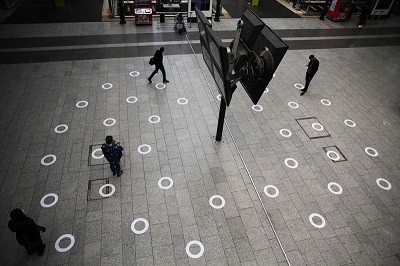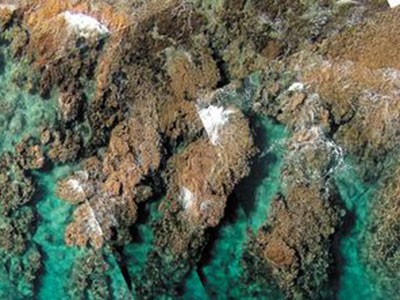Debojyoti Chakraborty took just a few months to develop a COVID-19 diagnostic test that worked in his lab; the challenge was to optimize it for the field.
Based on the gene-editing technology CRISPR, the test produces a band on a paper strip if viral RNA is present. But Chakraborty, who heads an RNA biology group at the Institute of Genomics and Integrative Biology in New Delhi, says he and his colleagues couldn’t always agree on whether a faint band counted as a positive signal. What they needed was an objective — and, ideally, portable — quantification tool. Then Chakraborty realized he already had one: his smartphone.
The researchers developed an app to photograph the paper strip, identify and quantify bands using machine learning, and export the results to the cloud. Called TOPSE1, their app laid the foundation for a test that has now been approved by the Drugs Controller General of India. “You can actually do this test in local pathology labs in places that are resource-limited,” Chakraborty says. “Perhaps one day it can be done even at home.”
The billions of smartphones in use worldwide offer unprecedented opportunities for disease tracking, diagnostics and citizen science, as Chakraborty learnt. Examples include apps that enable phone users to monitor COVID-19 symptoms, count disease-carrying mosquitoes and detect microscopic pathogens. They could even help the world to prepare for the next pandemic.
“These tools can be incredibly cheap to deploy, and they get real-time insights directly from people on the ground,” says John Brownstein, a computational epidemiologist at Boston Children’s Hospital in Massachusetts. “That kind of data can outpace what traditional surveillance provides.”
Portable epidemiology
Smartphone science didn’t start with COVID-19. But the pandemic has spurred researchers to fast-track citizen-science efforts that use smartphones to gather information about the disease. Volunteers can regularly log details about their symptoms, testing status and location through apps or websites. For instance, data from 5 million users of Brownstein’s crowdsourced tracker for influenza and COVID-19 — called Outbreaks Near Me — provided early evidence of the benefits of masking2. “You get these impressive insights that would be harder to collect from traditional health care quickly,” he says.
Such projects can be rapidly deployed, an advantage in a fast-moving public-health crisis. Cardiologist Gregory Marcus at the University of California, San Francisco, was able to take his team’s COVID-19 Citizen Science app from concept to 50,000 participants in under a year. “That would be impossible in a conventional research study,” he says. And because users enrol by downloading an app, such studies are easy to scale up and tweak: researchers can add questions about new vaccines or virus variants, for instance.
Claire Steves, who studies ageing at King’s College London, analysed data from the United Kingdom’s COVID Symptom Study app, which has been downloaded by some 4.5 million people. She and her team used data from the app to develop a predictive model that found that a loss of the sense of smell (known as anosmia) was a predictor of testing positive for COVID-193. The team also used data from the app to identify COVID-19 hotspots in the United Kingdom4 and to establish that long COVID, in which people experience persistent symptoms, was more likely in app users who had reported experiencing more than five COVID-19 symptoms in the first week of illness5.
Young children and older adults, who often don’t have smartphones, are under-represented in the COVID Symptom Study, Steves and her colleagues found. But thoughtful outreach, statistical analyses and cross-validation against other research can blunt those biases, she says. By comparing their results to the findings of UK COVID-19 tracking studies that used conventional designs, the team was able to validate its models4. “We’ve been able to show that our data very much reflect the data from [those] big population studies.”
Smartphones can track other diseases, too, such as malaria, Zika and dengue, which are spread through mosquitoes. Instead of sending technicians to trap and collect mosquitoes, Craig Williams, a public- and environmental-health scientist at the University of South Australia in Adelaide, posted traps to 126 volunteers in southern Australia and asked them to e-mail him smartphone photos of the trapped insects.
The project, called Mozzie Monitors, provided large-scale mosquito surveillance at 20% of the cost of a comparable professional surveillance programme6. “It has been surprising that citizen scientists were able to collect a higher abundance of mosquitoes than professional programmes in the same period, through a low-cost project from their backyards,” says Larissa Braz Sousa, a graduate student on Williams’s team who works on the project.
Williams has since added the option for volunteers in Australia to eschew traps and instead use a third-party app, iNaturalist, to photograph and identify the insects. This led to a nationwide trial in February, dubbed Mozzie Month. “We’re hoping to have the first national citizen-science mosquito-surveillance programme,” he says. “The smartphone is at the centre of that.”
Diagnosis by smartphone
Smartphone science comes down to three features: computing power, connectivity and cameras.
“Cameras on phones have become more and more sensitive over the past ten years, and what I needed a microscope for before I can do with my phone now,” says Rashid Bashir, a bioengineer at the University of Illinois in Urbana-Champaign. In 2017, Bashir and his team harnessed smartphone cameras in a point-of-care test that uses blood samples to check for viral infections. The cameras can spot fluorescent signals generated from amplified viral RNA, enabling detection of Zika, dengue and another mosquito-borne virus called chikungunya7. He has now updated the test to detect COVID-198.
In some cases, smartphone-based diagnostics can match expensive and bulky lab equipment for speed and accuracy, while remaining portable enough for field settings. Jeong-Yeol Yoon, a biomedical engineer at the University of Arizona in Tucson, coupled a smartphone with some off-the-shelf microscope components and the MATLAB Mobile app to detect norovirus, which causes about 20 million cases of gastrointestinal illness each year in the United States9. “We duplicated the bench-top fluorescence microscope, which can easily be US$50,000, for less than $40,” says Yoon, who is currently setting up clinical trials for both norovirus and COVID-19 versions of the test.
Melanie Ott, a virologist at the Gladstone Institute of Virology and Immunology in San Francisco, California, co-developed a smartphone-based COVID-19 diagnostic test10 with Daniel Fletcher, a bioengineer at the University of California, Berkeley. According to Fletcher, the test is more sensitive than standard laboratory plate readers, and faster than the gold-standard reverse-transcription PCR test for SARS-CoV-2. The smartphone-based test can also quantify how much virus a person is carrying, which could help to predict the risk of disease transmission and severity. Says Ott: “The phone is doing everything: it’s the camera that actually acquires the results, the computer that analyses the results, and it can send the result to the cloud for storage.”
Ensuring trust
Smartphones are a powerful way to do science, but gaining users’ trust is crucial if an app is going to be widely used and provide good data. Developers and other experts can help with this, as well as with the technological hurdles. App development is often tricky, but apps that collect health data require extra levels of privacy, security, support and regulatory compliance. Likewise, citizen-science projects must take care to anonymize and encrypt users’ data. “If we don’t get those things right, then it’s going to be impossible to build trust and get people to use these tools, so it’s a priority for us,” says Brownstein.
Such tools also generate a lot of data. The COVID Symptom Study app, for instance, was developed with the London-based data-science firm Zoe, which helped with both app design and data analysis. “You’re having responses from four-and-a-half million people potentially on a daily basis, so it’s very big data and it can be quite complicated,” says Steves.
Marcus helped to create a research platform called Eureka, funded by the US National Institutes of Health, which includes infrastructure that enables scientists to build and deploy mobile apps for health research. Eureka hosts the COVID Citizen Science Study, as well as more than 30 others. “The point is to help researchers utilize mobile technologies without having to have technology expertise, so they can focus on their clinical research and medical expertise,” he says.
That could help users and public-health efforts, too. Yoon envisions a future in which consumers pair over-the-counter kits with apps on their phones for convenient and regular testing, which could help to control future pandemics. “We need to identify the people who get infected, and if you can actually do it at home, I believe that can greatly decrease the spread of the disease,” he says. “We need to be ready for the next pandemic.”
"Smartphone" - Google News
May 10, 2021 at 06:05PM
https://ift.tt/3f7BA4f
Smartphone science: apps test and track infectious diseases - Nature.com
"Smartphone" - Google News
https://ift.tt/2QXWyGT
https://ift.tt/2KSW0PQ
Bagikan Berita Ini


















0 Response to "Smartphone science: apps test and track infectious diseases - Nature.com"
Post a Comment